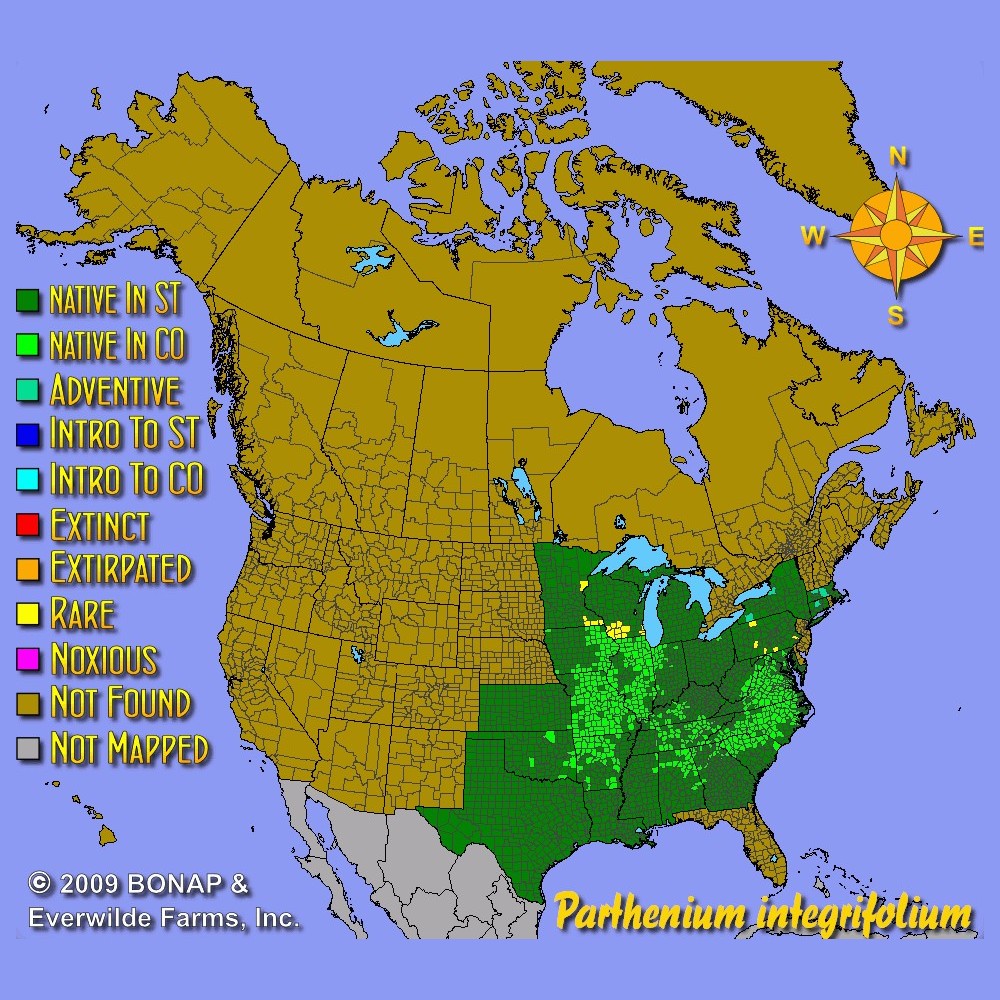Wild Quinine Seeds
- HOW TO GROW
- FAST FACTS
- REVIEWS
HOW TO GROW
Sowing: Sow wild quinine seeds in late fall or as soon as the soil can be worked in the spring. Plant just below the surface, lightly compacting the soil. Keep the soil consistently moist until germination. Do not attempt to move seedlings, since they resent having their roots disturbed. For spring planting, mix the seeds with moist sand and store in the refrigerator for 60 days before planting.
Growing: Water seedlings until they become established. Mature plants tolerate drought and grow well in either dry or moist soil, though they prefer moist soil. Do not attempt to move the plants, since they do not transplant well. In their first two years of growth, these seedlings will develop slowly as they concentrate on developing their large taproot; plants will begin blooming in their second or third year. In good growing conditions, they may spread by rhizomes. This plant has excellent resistance to disease and pests, and tolerates both heat and cold well.
Harvesting: For fresh flowers, choose flower clusters that have just opened. Strip away the foliage that will fall below the water level, and place in water immediately. For dried flower arrangements, hang the stalks upside-down in a warm, dry place until they have completely dried. For best results, leave space around each stalk for good air movement.
Seed Saving: Allow the clusters of flowers to turn slightly brown and dry on the stem; cut the clusters and spread them out to dry completely. Separate the seed from the husks, removing as much plant material as possible. Store the Parthenium integrifolium seed in a cool, dry place.
FAST FACTS
Common Names: American Feverfew
Latin Name: Parthenium integrifolium
Species Origin: US Native Wildflower
Type: Native Wildflowers
Life Cycle: Perennial
USDA Zones: 4, 5, 6, 7, 8
US Regions: Plains/Texas, Midwest, Northeast, Southeast
Seeds per Ounce: 6,900
Stratification: Cold/Wet for 8 Weeks
Germination Ease: Stratify 8 Weeks
Sunlight: Full Sun
Height: 40 Inches
Color: White
Bloom Season: Blooms Early Summer, Blooms Late Summer, Blooms Early Fall
Uses: Attracts Pollinators, Attracts Honeybees, Attracts Butterflies, Cut Flowers, Deer Resistant
Too late in the season to grow.
Will plant this at the end of winter so that it can grow in spring. Cannot wait to grow.
Great seeds
I've been ordering from Everwilde for over 10 years. The germination rates are always excellent and the shipping is lightening fast!
Seeds
Great packaging and price!
Good service
The product was sent in a timely manner. The price is very good.
Quality seed.
I recieved the seed I ordered quickly and they where packaged professionally for good germination.
DESCRIPTION

HOW TO GROW
Sowing: Sow wild quinine seeds in late fall or as soon as the soil can be worked in the spring. Plant just below the surface, lightly compacting the soil. Keep the soil consistently moist until germination. Do not attempt to move seedlings, since they resent having their roots disturbed. For spring planting, mix the seeds with moist sand and store in the refrigerator for 60 days before planting.
Growing: Water seedlings until they become established. Mature plants tolerate drought and grow well in either dry or moist soil, though they prefer moist soil. Do not attempt to move the plants, since they do not transplant well. In their first two years of growth, these seedlings will develop slowly as they concentrate on developing their large taproot; plants will begin blooming in their second or third year. In good growing conditions, they may spread by rhizomes. This plant has excellent resistance to disease and pests, and tolerates both heat and cold well.
Harvesting: For fresh flowers, choose flower clusters that have just opened. Strip away the foliage that will fall below the water level, and place in water immediately. For dried flower arrangements, hang the stalks upside-down in a warm, dry place until they have completely dried. For best results, leave space around each stalk for good air movement.
Seed Saving: Allow the clusters of flowers to turn slightly brown and dry on the stem; cut the clusters and spread them out to dry completely. Separate the seed from the husks, removing as much plant material as possible. Store the Parthenium integrifolium seed in a cool, dry place.
FAST FACTS
Common Names: American Feverfew
Latin Name: Parthenium integrifolium
Species Origin: US Native Wildflower
Type: Native Wildflowers
Life Cycle: Perennial
USDA Zones: 4, 5, 6, 7, 8
US Regions: Plains/Texas, Midwest, Northeast, Southeast
Seeds per Ounce: 6,900
Stratification: Cold/Wet for 8 Weeks
Germination Ease: Stratify 8 Weeks
Sunlight: Full Sun
Height: 40 Inches
Color: White
Bloom Season: Blooms Early Summer, Blooms Late Summer, Blooms Early Fall
Uses: Attracts Pollinators, Attracts Honeybees, Attracts Butterflies, Cut Flowers, Deer Resistant
Reviews
Review
Too late in the season to grow.
Will plant this at the end of winter so that it can grow in spring. Cannot wait to grow.
Review
Great seeds
I've been ordering from Everwilde for over 10 years. The germination rates are always excellent and the shipping is lightening fast!
Review
Seeds
Great packaging and price!
Review
Good service
The product was sent in a timely manner. The price is very good.
Review
Quality seed.
I recieved the seed I ordered quickly and they where packaged professionally for good germination.





